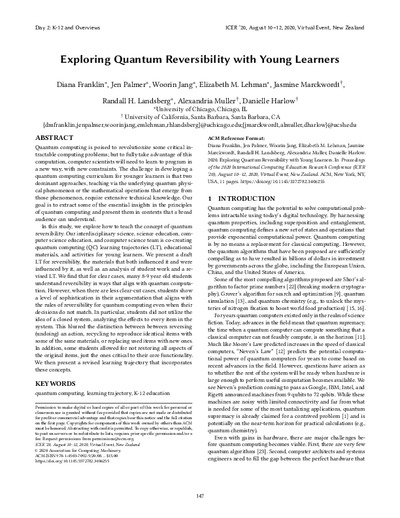Exploring Quantum Reversibility with Young LearnersDiana Franklin, Jen Palmer, Woorin Jang, Elizabeth M. Lehman, Jasmine Marckwordt, Randall H. Landsberg, Alexandria Muller, Danielle Harlow
Publikationsdatum:
Zu finden in: ICER 2020 (Seite 147 bis 157), 2020
|
 |
 Diese Seite wurde seit 2 Jahren inhaltlich nicht mehr aktualisiert.
Unter Umständen ist sie nicht mehr aktuell.
Diese Seite wurde seit 2 Jahren inhaltlich nicht mehr aktualisiert.
Unter Umständen ist sie nicht mehr aktuell.
 Zusammenfassungen
Zusammenfassungen
Quantum computing is poised to revolutionize some critical intractable computing problems; but to fully take advantage of this computation, computer scientists will need to learn to program in a new way, with new constraints. The challenge in developing a quantum computing curriculum for younger learners is that two dominant approaches, teaching via the underlying quantum physical phenomenon or the mathematical operations that emerge from those phenomenon, require extensive technical knowledge. Our goal is to extract some of the essential insights in the principles of quantum computing and present them in contexts that a broad audience can understand.
In this study, we explore how to teach the concept of quantum reversibility. Our interdisciplinary science, science education, computer science education, and computer science team is co-creating quantum computing (QC) learning trajectories (LT), educational materials, and activities for young learners. We present a draft LT for reversibility, the materials that both influenced it and were influenced by it, as well as an analysis of student work and a revised LT. We find that for clear cases, many 8-9 year old students understand reversibility in ways that align with quantum computation. However, when there are less clear-cut cases, students show a level of sophistication in their argumentation that aligns with the rules of reversibility for quantum computing even when their decisions do not match. In particular, students did not utilize the idea of a closed system, analyzing the effects to every item in the system. This blurred the distinction between between reversing (undoing) an action, recycling to reproduce identical items with some of the same materials, or replacing used items with new ones. In addition, some students allowed for not restoring all aspects of the original items, just the ones critical to their core functionality. We then present a revised learning trajectory that incorporates these concepts.
 Dieses Konferenz-Paper erwähnt ...
Dieses Konferenz-Paper erwähnt ...
 Personen KB IB clear | T. Andrew Binkowski , Brian A. Danielak , Brendan Foreman , Diana Franklin , Cheryl Moran , Kathryn M. Rich , Linda M. Seiter , Carla Strickland | ||||||||||||||||||||||||||||||||||||
 Begriffe KB IB clear | Dr. Scratch , Informatikcomputer science , Informatik-Unterricht (Fachinformatik)Computer Science Education | ||||||||||||||||||||||||||||||||||||
 Bücher |
| ||||||||||||||||||||||||||||||||||||
 Texte |
|
 Dieses Konferenz-Paper erwähnt vermutlich nicht ...
Dieses Konferenz-Paper erwähnt vermutlich nicht ... 
 Nicht erwähnte Begriffe | Informatik-Didaktik, Informatikunterricht in der Schule |
 Tagcloud
Tagcloud
 Zitationsgraph
Zitationsgraph
 Zitationsgraph (Beta-Test mit vis.js)
Zitationsgraph (Beta-Test mit vis.js)
 1 Erwähnungen
1 Erwähnungen 
- WIPSCE '23 - The 18th WiPSCE Conference on Primary and Secondary Computing Education Research (Sue Sentance, Mareen Grillenberger) (2023)
- A Systematic Literature Review on Physical and Action Based Activities in Computing Education for Early Years and Primary (Anaclara Gerosa, Maria Kallia, Quintin I. Cutts) (2023)


- A Systematic Literature Review on Physical and Action Based Activities in Computing Education for Early Years and Primary (Anaclara Gerosa, Maria Kallia, Quintin I. Cutts) (2023)
 Anderswo finden
Anderswo finden
 Volltext dieses Dokuments
Volltext dieses Dokuments
 |  Exploring Quantum Reversibility with Young Learners: Fulltext at the ACM Digital Library ( Exploring Quantum Reversibility with Young Learners: Fulltext at the ACM Digital Library ( : :  , 4270 kByte; , 4270 kByte;  : :  ) ) |
 Anderswo suchen
Anderswo suchen 
 Beat und dieses Konferenz-Paper
Beat und dieses Konferenz-Paper
Beat hat Dieses Konferenz-Paper während seiner Zeit am Institut für Medien und Schule (IMS) ins Biblionetz aufgenommen. Beat besitzt kein physisches, aber ein digitales Exemplar. Eine digitale Version ist auf dem Internet verfügbar (s.o.). Aufgrund der wenigen Einträge im Biblionetz scheint er es nicht wirklich gelesen zu haben. Es gibt bisher auch nur wenige Objekte im Biblionetz, die dieses Werk zitieren.











 Biblionetz-History
Biblionetz-History